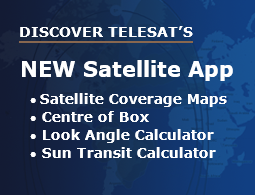Satellite technology has traditionally been considered a last-resort option by telecom operators to reach remote populations. Challenges such as high costs for satellite bandwidth and equipment, along with compatibility issues with established telecom standards, have hindered the realization of its full potential in the telecom ecosystem.
This scenario is swiftly changing due to the introduction of Low-Earth-Orbit (LEO) satellite networks. Interest in LEO constellations has exploded in recent years, fueled by ubiquitous, high-throughput, low-latency connectivity, coupled with disruptive pricing. These new capabilities change the space-based connectivity equation entirely and greatly increase the addressable market for enterprise connectivity. Telesat estimates that this market will reach $320B by 2032.
A key advantage of LEO technology lies in its ability to provide a “virtual fiber” network that can reach any point on earth. These non-terrestrial networks (NTNs) allow telecom providers to reach users in remote areas that are beyond the reach of terrestrial networks. Currently, about 8% of the world’s population, approximately 500 million people, reside in areas without access to 3G, 4G, or 5G mobile networks – without internet access, as reported by the GSMA. LEO presents a significant growth opportunity for telecom service providers to collaborate with satellite operators in order to bridge this connectivity gap.
The broad enterprise transition to cloud computing has led telecom operators to offer Network-as-a-Service (NaaS) platforms to their customers. Leveraging Carrier Ethernet via satellite enables telecommunications service providers to expand the service geography of their offerings, providing SD-WAN and IP services, cloud connectivity, and advanced 5G applications beyond the footprint of their core terrestrial networks.
However, for satellite operators to participate in this new market opportunity, the integration of satellite connectivity must be frictionless and accommodate an automated ecosystem. Previously, interoperability was not possible due to satellite networks’ proprietary characteristics. The deployment process was manual and labor-intensive and could extend over weeks or even months. This situation has changed significantly as several satellite operators and ground system providers adopt MEF standards. This shift and the introduction of application programming interfaces (APIs) are transforming the service experience and unlocking the potential of terrestrial and NTN service orchestration.
NTNs need to be fully API-driven and require standards-based automation between ecosystem players at both business and operational levels. MEF has developed standards-based Lifecycle Service Orchestration (LSO) business and operational process APIs that uniquely provide the high fidelity (tightly defined context), plug-and-play interoperability, and extensibility required by service providers to “invest once” and efficiently scale implementations with many partners and services.
Within the MEF LSO Framework, Business APIs address the layer of interactions between partners by automating elements of the product lifecycle for MEF standard services, such as for product catalog, quote, order, and inventory, in order to accelerate service delivery and improve customer experience. As an example, a service provider would provide a request to serve an off-network enterprise customer and communicate the details seamlessly to a satellite operator using the LSO Sonata APIs that enable such automation between partners business domains.
The necessary service requirements for the satellite operator could then flow down through other LSO APIs to their operational systems, orchestrating the virtual infrastructure and resources needed to deliver the end-to-end automated service to meet the specific customer request. This kind of automation can have significant implications for improved service delivery and operational performance for all parties involved.
Additionally, the MEF LSO Framework has defined Operational APIs, further automating elements of the MEF standard service lifecycle functionalities between partners, such as for direct service inventory, test, performance, and fault management.
Telecom service providers will now deliver standard connectivity using Carrier Ethernet services over satellite in the same way that they deliver all their other enterprise services. The telecom service provider can automate the delivery of services in minutes to remote sites and easily view and manage the performance of the combined end-to-end network to ensure a high-quality customer experience.
A growing number of satellite operators and service providers have joined MEF due to this convergence of satellite and telecom networks. According to MEF, 122 service providers worldwide are now in some stage of the LSO adoption lifecycle, and forecasts companies in LSO production will increase rapidly between now and the end of 2025.
Telesat is purposely designing its network for seamless interoperability with telecom networks. Telesat Lightspeed services will be certified through MEF, ensuring that they conform to their rigorous certification standards. With MEF’s 3.0 standards, companies can easily understand the capabilities provided by Telesat Lightspeed and how these software-defined digital services can be procured and integrated into their networks.
By designing Telesat Lightspeed to MEF standards, customers can take advantage of ubiquitous, high-capacity, and low-latency connectivity without the complexities inherent in integrating traditional satellite-based solutions. The addition of the MEF LSO ensures that all back-end processes business and operational processes between the telecom provider and satellite operator are efficient and automated.
LEO broadband networks certified by MEF will transform satellite connectivity from a last resort for telecom operators to an indispensable part of their Carrier Ethernet services.




